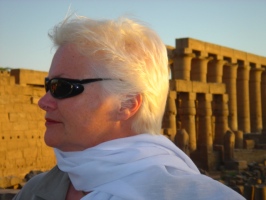Originally written for Westminster College’s Travel Writing class, Fall 2006
The sharp pork, corn, and chili aromas from tamales filled the air as the tour group stood in front of Los Angeles’ Union Station looking over at Olvera Street. “Let’s meet back at El Paseo at 11:30 for lunch,†said Janice, our guide. “El Paseo,†a woman on the tour said, deep in reverie. “I used to dance there in the ‘50s.†Maria Morca was in her 70s, but she kept the elegant posture of a flamenco artist. “Olvera Street was a prestigious place to dance 50 years ago, “she added.
We were all aware of Olvera Street’s reputation as a tourist trap in the “old town†of Los Angeles, but the area is now in the middle of an energetic renovation. It was worth a second look. Olvera (“ole-VERR-ahâ€) Street is a two-block-long Mexican marketplace and—fairly unique in this City of Automobiles—for pedestrians only. Gene Kelly danced around its small fountain in the 1945 movie Anchors Aweigh.
The street is still lined with the original wooden puestos (merchandise stalls), and many have been converted into restaurants, cafés, and art studios. The ruffled embroidered blouses, paper flowers, skulls made out of sugar for DÃa de los Muertos (“Day of the Deadâ€), and the T-shirts of Pancho and Ché have all been made in Mexico. There’s not an hecho en China to be seen.
Built on the site of an Indian village and an early Chinatown, the marketplace was originally called Calle Vino (“Wine Street,†after nearby vineyards and a winery). Don AgustÃn Olvera arrived in California from Mexico in 1841 and bought an adobe home on the north side of the plaza. As the first judge of L.A. County, he often held court proceedings there. The street was officially renamed Olvera Street after the judge died in 1876.
Olvera Street was now a mix of USC football fans, families and couples, college students, and tour groups. In front of the church, a nervous wedding party posed for the photographer. Nearby, little girls twirled in their bodas (christening dresses), and squirmy little boys in white tuxedos held tightly to their fathers’ hands. Visitors chatted at outdoor tables over great plates of enchiladas, rice, and beans.
The large plaza on Olvera Street’s south end is surrounded by museums (including the newly opened Chinese-American Museum), historical homes, and churches. Tourists strolled in lazy circles, holding cinnamon-sprinkled churros and multi-flavored Jarritos sodas. Children begged for marionettes and skeleton piñatas that were hanging in the shops. Parents hoisted toddlers onto Jorge, the stuffed donkey, for photographs, as an assistant added serapes and sombreros—pink for the girls, black for the boys. A piper was playing “My Heart Will Go On†from Titanic. Olvera Street may remain a Southern California tourist icon, but it is clean, colorful, energetic, and family-friendly.
“My parents sent me to secretarial college,†Maria said, “but it didn’t take. I always wanted to be a dancer. We wore lots of ruffles and polka dots back then, doing the farruca and sevillanas dances. Yes, this was a prestigious place to dance, and it always had a festive spirit.†The spirit of Olvera Street is festive again.
WHY GO? Olvera Street is the old town center of the original El Pueblo de la Reina de Los Angeles, founded in 1781. It’s clean, safe, and easy to get to by car, light rail, and train.
HOW TO GET THERE: From Salt Lake City, the drive via I-15 takes about 12 hours. Olvera Street is just across Alameda Street from Union Station where Amtrak passengers arrive from all over the country.
WHAT IT WILL COST: To avoid parking hassles, three dollars will get you a Metro light-rail roundtrip. L.A. Metro station maps and timetables are available at www.mta.net
NOT TO MISS: Shopping! Mexican dresses and shawls, Day of the Dead items, piñatas, tooled leather, marionettes, and musical instruments are featured.
WHERE TO EAT: La Golondrina Café was the first Mexican restaurant in Los Angeles. Also good are La Luz del DÃa, El Paseo, Juanita’s, Las Anitas, and Cielito Lindo.
WEATHER: Olvera Street is an outdoor experience, and Southern California is mild year-round. However, summers can be hot away from the ocean, autumn brings Santa Ana winds off the desert, and L.A. winters feature fog and rain.
MORE INFORMATION: www.olvera-street.com and www.cityofla.org

Post a Comment